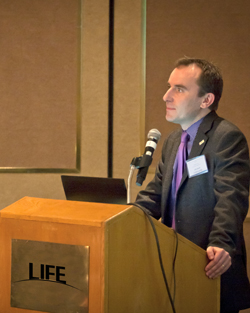The People of NIF
Mike Dunne: Fusion Advocate
For Mike Dunne, director for Laser Fusion Energy, it was two charismatic physics teachers that set him on his academic course. One was an Imperial College London professor with a bit of a mad scientist flair. Dunne chose to do his Ph.D. with him because he was "so passionate and committed." These same characteristics suitably describe Dunne, especially when he speaks about laser fusion as an energy solution. His mission is to solve one of society's most profound problems—how to meet the world's ever-expanding energy demands while sharply curtailing the release of greenhouse-gas emissions that contribute to climate change.
 Laser fusion advocate Mike Dunne.
Laser fusion advocate Mike Dunne.
Lasers and laser fusion have loomed large in Dunne's career. After earning his Ph.D. in plasma physics and continuing on as a researcher at Imperial College, Dunne was offered a position at the UK's Atomic Weapons Establishment (AWE), a place where he would spend the next 10 years. Dunne notes that during this time, the UK government was evaluating whether to mothball or invest in the laboratory there. He helped put together a successful funding proposal that tripled the laboratory's budget and funded new facilities, including a laser facility that he co-sponsored. This facility, Orion, was recently completed and will begin operation in 2011. Dunne observes, "Working at AWE taught me about working with the government and about looking beyond incremental improvements. I learned that one shouldn't be put off by the status quo, or the scale of the challenge. If there's a need, things can be made to happen."
Then an opportunity arose for Dunne to run the UK's Central Laser Facility at the Rutherford-Appleton Laboratory. Running a user facility and interacting with scientific leaders on an international stage was quite a change, he notes, after the closed environment at AWE. Rather than overseeing primarily physics-based research as before, he was now leading a science program that encompassed medicine and biology, too. Dunne recalls, "It was a diverse community and a fun job. We were working to set up new capabilities and facilities through peer-reviewed competitions." Some of these projects were successfully spun off into companies that developed the technologies.
While at the Central Laser Facility, Dunne established the European High Power laser Energy Research (HiPER) project, an effort that Dunne marks as a career highlight. In 2005, he started working with European scientists and policy makers to look toward the demonstration of ignition on NIF and contemplate the next steps—pursuing laser-driven fusion as a future energy source. The laser communities in Europe were most familiar with working at the laboratory or national scale, though, and getting institutions to sign onto an international project like HiPER required overcoming significant skepticism and cultural differences. Dunne says, "The goal for me was to get European players to work on the project together. It was really fulfilling. It was a transformative journey from widely scattered opinions and prejudices to a real community that developed." Eventually, 26 institutions across 10 countries joined the project.
Dunne's involvement in the HiPER program ultimately motivated him to come to LLNL, which he did in 2010. Dunne says, "I spent five intensive years developing the field: finding out how to deliver fusion energy soon enough to make a difference. I saw that without the direct and central involvement of LLNL, this goal would not happen. I wanted to help, to pull this vision forward." An additional enticement to the move, he quips, is that "the weather is a bit warmer here, too." Moving to a new country and shifting from being the head of a laser facility to being part of a much larger organization takes some adjustment, but Dunne has nothing but praise for his new workplace. "Working here, the sheer breadth and depth of capability is staggering," he says. "People here are so focused on making NIF work. So many people have a passion for taking forward the consequences of ignition and tackling the energy issue."
Work days constantly challenge his discipline and focus, he admits: "I'm trying to deal with what comes in while maintaining direction for the project as a whole and not being buffeted by the crises that pop up." No matter the number of demands awaiting him at work each morning, though, Dunne maintains perspective. The demonstration of fusion ignition on the National Ignition Facility, he says, will be a key moment both for the advancement of science and for developing solutions to the twin problems of climate change and increasing energy demand: "Fusion offers one of the few ways of unraveling these immense problems of climate and energy supply. We are on the cusp of a truly momentous event that people will look back on for decades to come. We should not take this for granted, nor squander the opportunity it represents. These are decisive times."




